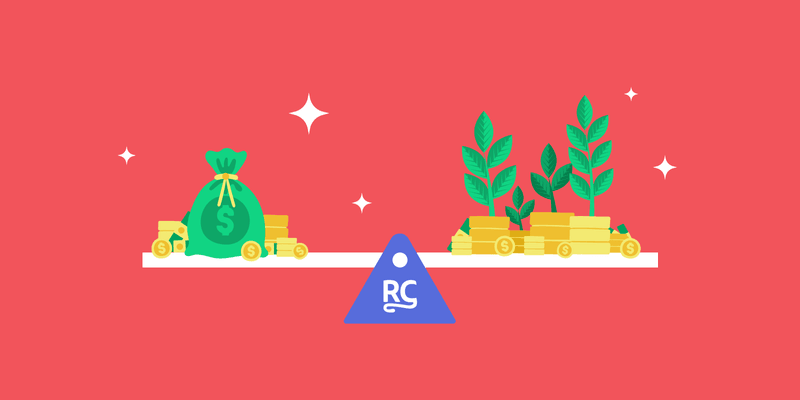Smart discounting strategies: When, why, and how to offer deals
Smart discounting strategies: Use deals to drive growth without risking your app’s profitability.

Discounting is a big part of a pricing strategy and is a common tool for consumer apps to grow and increase their revenues. Almost any app you use offers some kind of discount at some point. The main aim of the discounted sales is to do a price reduction to generate enough supplementary sales to compensate for the reduction in income. However, few companies truly understand the long-term cost of discounts.
Let’s take this example – a typical mobile app that does around $100K MRR usually sells a subscription for $39.99, and typically sells 100 of them per day. If they offer a 50% discount, bringing the price down to $19.99, they may see an increase in sales to 120 subscriptions per day.
However, the 20 additional items sold at the discounted $19.99 price only generate less than $400 in revenue. But the app also had to discount the 100 subscriptions they would have sold anyway, losing $20 per subscription, or around $2,000 in total.
So the net result is a loss of $1,600 in revenue, even though the total number of items sold increased. The challenge for growth professionals is to find the right balance – a discount level that generates enough additional sales to offset the revenue lost on discounted baseline sales. Setting the wrong discount level can lead to decrease in LTV, huge long-term revenue cannibalization, decrease in ROAS and increase in customer pay-back period.
In this article, I’ll highlight some strategies you can use to implement discounting in a smart way while avoiding common pitfalls. These strategies are not universal truths for every type of app but provide a solid foundation for developing your own discounting strategy.
Subscription conversion rate plateau
In most cases, new users are most likely to subscribe or convert to a paid plan within the first 3 days of signing up. This initial window of high conversion likelihood is known as the “subscription conversion rate spike”.
During this early period, new users are most engaged and excited, making them more likely to subscribe.. However, over time, the subscription conversion rate gradually decreases. The likelihood of a new user subscribing tapers off as they become more accustomed to the free version and their initial enthusiasm wears off.
That said, there may be occasional spikes in conversion rate even after the initial 3-day window. For example, the company may release a major new feature that reignites user interest and boosts conversions.
Eventually, the subscription conversion rate will stabilize at a lower, more consistent level. This is known as the “subscription conversion rate plateau”. At this point, the company is seeing a steady, albeit lower, stream of new subscribers from its existing user base.
This stabilized conversion rate, while lower than the initial spike, can still represent a sizable portion of the overall user base. And therein lies an untapped opportunity for revenue growth through promotional strategies like discounting.
The cohort who reached the ‘subscription conversion rate plateau’ are one of the best target audiences for discounted sales campaigns. So, analyze your data to identify the day when the subscription conversion rate plateaus. Then offer discounted sales to potentially convert more of these “plateau” users into paid subscribers. This allows mobile apps to expand their revenue from existing user cohorts without cannibalizing too much of the revenue or lowering the overall LTV.

Measuring & minimizing cannibalization
One of the common issues that happens with discounted sales is cannibalization. Cannibalization refers to the phenomenon where a discounted subscription ends up taking sales away from the company’s regular, full-price offering. In other words, the discounted version “cannibalizes” some of the sales that the regular product would have gotten otherwise.
Avoiding cannibalization entirely is nearly impossible—I’ve yet to see a case where discounts didn’t lead to some loss in full-price sales.. However, the good thing is that it’s possible to minimize by taking necessary actions.
Taking some user segments out of the discounted sales or never provide discounts
One of the most effective strategies to minimize cannibalization is to selectively apply discounts to certain customer segments. These segments should be carefully chosen to exclude your “free power users” – those customers who are already using the free version of the product but also have characteristics indicating a higher willingness to pay.
For example, you could exclude from the discount offer:
- Customers in high-spending markets, like the US, where price sensitivity is lower
- Customers using the latest iOS devices, as they tend to have higher spending power
- Customers in the 27-40 age range, as they are more likely to be in professional roles with disposable income
The question is, should you completely ignore these high-value users? The answer is no, but you need to use a different approach with them. For example, you could offer discounts on 2-year plans instead of just 1-year plans. You could also try other promotional tactics, like a “Buy 1, Get 1 for free” offer. The main idea here is to be ‘smart’ and to not hurt the long-term LTV of these users.
Estimate the incremental demand the discount will generate
Before running discounted sales or deciding to give some user segments discounts it’s better to try to estimate the demand you’ll generate by offering a discount. This is a difficult thing to do for smaller apps but for the big ones they have enough data to try to run somewhat precise analysis. There are two ways you can do this 1) calculating the price elasticity of demand 2) running estimations based on the previous campaigns you did.
The price elasticity of demand gives us insight into how customers will likely react to a price change. If demand is elastic (price elasticity > 1), it means consumers are quite sensitive to price – a small price decrease will lead to a larger increase in quantity demanded. Conversely, if demand is inelastic (price elasticity < 1), it indicates consumers are less sensitive to price changes – a price decrease may only lead to a modest rise in quantity demanded.
Suppose an app currently sells a product for $100, and it has a price elasticity of demand of -2. This means a 1% decrease in price will lead to a 2% increase in quantity demanded.
If they were to offer a 20% discount, dropping the price to $80, we can calculate the expected increase in quantity demanded:
- Price decrease = 20%
- Price elasticity = -2
- % Change in Quantity Demanded = Price elasticity x % Change in Price = -2x -20% = 40%
So a 20% discount on a product with a price elasticity of -2 would be expected to increase quantity demanded by 40%.
This provides an estimate of how much additional demand a discount could generate.. You can then use this information to model the potential revenue impact, accounting for both the increased volume and the lower per-unit price.
Of course, our world is not linear, and only relying on this might not be very helpful. So, it’s better to also cross-check this number by looking at the conversion rates of different discounts you’ve run before and the results of price A/B tests.
Using discounts to improve ROAS
Many apps rely on paid ads as one of their primary distribution channels. As this space becomes increasingly competitive and expensive, maintaining a good ROAS and a shortened payback period is crucial. This is essential because you need capital to reinvest in paid ads and sustain growth. Offering discounts to these users can help achieve this.
Let’s take the example of a company trying to achieve a positive ROAS by D7 from Apple Search Ads. They invest money to acquire new cohorts of users to increase revenue. However, if they don’t achieve a strong conversion rate at the original price within the first few days, it’s highly unlikely they will reach a positive ROAS by D7. This is where discounting comes into play—targeting that specific cohort of users with discounted offers to help optimize the ROAS.
There are usually two ways you can do it: you can immediately show them second-time offers, which will basically be a discount, or you can show the discount a few days later and use that time to nudge them to subscribe at the full-price offer. There is no universal truth, and the option you choose depends on several factors, such as the payback period you need and the retention rate of your app. However, for apps with low retention rates, like workout or fitness apps, you can start offering discounts immediately with second-time purchase offers or by providing discounts during the next 1–3 user sessions.
There are usually two ways to approach this. You can immediately show second-time offers, which are essentially discounts. Or, you can delay the discount by a few days and use that time to nudge users to subscribe at the full-price offer. The best option depends on factors like your app’s payback period and retention rate. For apps with low retention rates, such as workout or fitness apps, offering discounts right away—either as second-time purchase offers or during the next 1–3 user sessions—can be more effective.

In summary
To sum up, discounting a very important part of the pricing strategy. However, if you don’t use it in a smart way, it can be more harmful in the long run than helpful. You might feel you’re gaining revenue in the short term by running untargeted or unstructured discount campaigns. But in the future, you’ll face challenges like cannibalized revenue, low LTV, and poor renewal rates. It’s important to plan carefully and structure your approach to optimize revenue in both the short and long term.
You might also like
- Blog post
Modeling attribution on iOS: what works, what doesn’t, and how to choose
How to navigate the messy world of SKAN, AEM, and probabilistic attribution — plus two practical frameworks to get a clearer picture of campaign performance.
- Blog post
Your sprints must pay for themselves: Dan Layfield’s product advice
What’s worth building? Dan Layfield shares a 3-bucket framework to help app teams prioritize features, fix churn, and ship faster.
- Blog post
Is monetization hurting your app’s user experience?
Don’t trade short-term revenue for long-term trust. How ethical UX can still drive effective monetization.

